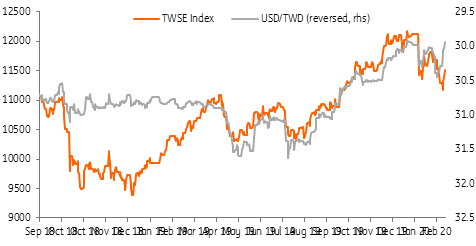Taiwan: Negative inflation reflects damage from coronavirus
Taiwan’s Consumer Price index and Wholesale Price Index were both negative on a yearly basis. This reflects the hit to consumers and manufacturers from the coronavirus. But we don’t expect a policy rate cut by the central bank. Even without a rate cut, the Taiwan dollar could soften by the end of the first quarter
Negative inflation rates
The CPI was -2.1% year-on-year in February while the WPI was -4.47 YoY. It is quite rare for Taiwan to see negative CPI inflation, though the WPI measure has been in negative territory since May 2019.
Not deflation, yet
The negative CPI reading in February is just one data point so it's too early to talk about deflation. The last time Taiwan recorded a negative CPI inflation rate was back in December 2018, when it was -0.06%YoY.
Damage from coronavirus confirmed
The data reflects the damage done to the economy by the coronavirus. When consumers are not working, they're spending most of their time at home, which has had a severe impact on retailers. This will likely continue until the number of new confirmed cases ends, which could possibly take another couple of months.
But the central bank is not going to cut rates
We do not expect Taiwan's central bank to cut the policy interest rate, which is now at 1.375% and has not moved since June 2016.
The main reason is that an interest rate cut will do nothing to combat the actual health emergency. The government has already planned to deliver consumption coupons to consumers and tourists after the epidemic ends. This may help struggling retailers a little, but could also make the central bank comfortable in its current policy position.
Capital inflows support TWD
There have been inflows of capital to Taiwan, which is another reason that we don't think a rate cut is likely given that there is more money in the system.
As inflows continue, USD/TWD has strengthened to around 30.00 from 30.45 on 24 February 2020.
We forecast a weaker TWD by end of 1Q20
But the Taiwan dollar strength could be temporary.
As the global supply chain is increasingly at risk from further disruption in South Korea, Japan, Europe and the US, production in Taiwan could be affected even if Mainland China’s factories try to resume operations.
We, therefore, forecast that USD/TWD could reach 30.20 by the end of 1Q20.

This publication has been prepared by ING solely for information purposes irrespective of a particular user's means, financial situation or investment objectives. The information does not constitute investment recommendation, and nor is it investment, legal or tax advice or an offer or solicitation to purchase or sell any financial instrument. Read more
Download
Download snap
6 March 2020
Good MornING Asia - 9 March 2020 This bundle contains 7 Articles